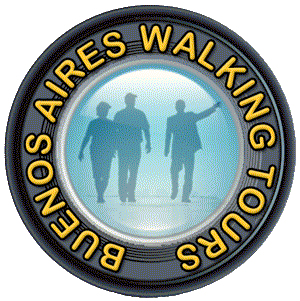Tour Outline (abbreviated): (click on pictures to toggle size)
This walk, lead by a savvy guide is by far the best way to experience Jewish Buenos Aires. You will have the undivided attention of our multi-lingual guide who knows this city in-and-out with its Jewish stories, history, legends, habits, curiosities, neighbourhoods, people, restaurants, circuits... the whole nine yards!
Argentine-born Nazi Top-Rank Commanders in WW2 Germany

Had any Argentines part in the development of Nazism in Germany?
When did the first settlers from Germany arrive in Argentina?
How many german soldiers came here in 1536? Why? (yes 1536, just 44 years after Columbus!)
Richard Walther Darré was born in Argentina as Ricardo Walther Oscar Darré and he was one of the leading Nazi 'blood and soil' ideologists (in German: Blut und Boden) and served Hitler directly as the Reichsminister of Food & Agriculture from 1933 to 1942. When World War ended, Darré was the senior-most Gestapo-Obergruppenführer ('Supreme group leader'), with date of rank from 9 November 1934, outranked only by Heinrich Himmler and other four Gestapoi-Oberst-Gruppenführer.
'Made in Argentina'?? Yes, Darré was born in a Buenos Aires neighbourhood called 'Belgrano' to German born Richard Oscar Darré and the Swedish/German Emilia Berta Lagergren. His father had moved to Argentina in 1888.
Studying when young in Germany, Darré initially joined the Artaman League, a youth-group committed to the 'back-to-the-land' movement. In it he began to develop the idea of the linkage between the future of the German race and the soil which became known as 'Blut & Boden', were 'Blut' or blood represents race / ancestry, and Boden soil / territory / land. The theory involved the relationship between a people and its land. Those who liked Darré's arguments included Heinrich Himmler himself.
In July 1930, after being introduced him to Adolf Hitler, Darré joined the Nazi Party and the SS (Schutzstaffel or Gestpo). Darré went on to become an active Nazi Reichsleiter (highest position attainable in any Nazi organisation). In 1932, Reichsführer-SS Himmler made him chief of the newly created SS Rasse und Siedlungshauptamt (Race and Settlement Main Office), a racist & antisemitic movement. Darré implemented racial policies and was concerned with the racial integrity of the members of the SS.
In 1933 he became Reich Minister of Food and Agriculture. He developed a plan for 'Rasse und Raum' ('race and space', or territory) which provided the ideological grounds for Nazi expansive policy. He strongly influenced Himmler in his goal to create a German racial aristocracy based on selective breeding. The Nazi policies of eugenics would lead to the annihilation of millions of non-Germans.
In 1945 the American authorities arrested Darré and tried him at the Nuremberg Trials. Found guilty, Darré was sentenced to seven years at Prison. He nevertheless was released in 1950 and spent his final years in Germany. (Source: Wikipedia)
(top...)
Shoah Museum Buenos Aires
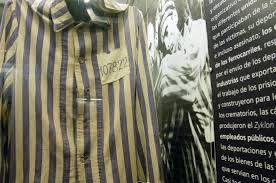
When did Jewish immigration to Argentina start?
When was the first local (Argentina) 'pogrom'?
How many bombings did we have to Jewish community buildings?
What happened to the prosecutor that took the case?
The Buenos Aires Shoah Museum, unique in Latin America, serves as a museum, memorial and reminder of the Holocaust and its impact in Argentina and rest of South America.
Supported through the Holocaust Memorial Foundation, it follows the slogan, ‘To remember is to avoid repeating history’ to keep the memory of the Holocaust present, honor those lost and to serve as a reminder of the atrocities committed.
The 'Museo del Holocausto' is set in a spacious red brick building, and its space is appropriately dim.
Among the artifacts usually exhibited, are the fake Italian passport used by Aldof Eichmann to enter Argentina in 1950 (a recent discovery).
The Holocaust Museum’s emphasizes the legacy of survivors. Portraits of survivors who moved here are accompanied by their personal stories and testimony.
When many jews came to Argentina in 1947, the country did not allow their permanence. Their Argentine visa denoted Semitic origin and stamped onto the paper is an image of the Star of David, not unlike documentation jews in German-occupied Europe would have held.
The museum publishes a magazine called ‘Nuestra Memoria,’ (Our Memory) which provides historical analysis of the Holocaust and its consequences and keeps a library of thousands of volumes of Holocaust-related literature in Spanish, German, Yiddish, and Polish.
(top...)
Main Synagogue
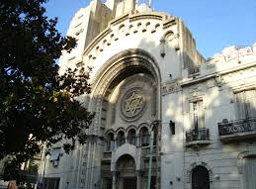
How many Jews in Argentina?
When did they first arrive?
Have there been any large attacks to the Jewish community here?
What do the symbols in the facade mean?
What can you find inside this building?
First Jewish immigrants arrived about the mid 19th century, mainly from Germany, England, and France. Later they also came from Poland and Rusia. Soon after getting here, they found out there weren’t any official laws allowing marriages other than weddings in Catholic Churches, and they were therefore not able to marry.
These immigrants created institutions that represented their own creeds. This temple’s design is inspired by the mid nineteenth century German temples, with Romanic and byzantine influences. The façade includes the Star of David, the tablets of the Ten Commandments and two hands representing a blessing of priests in old Jerusalem (mention Dr. Spock of Startrek fame) and there are twelve medallions on the entrance gate representing the twelve tribes of Israel. Construction started in 1897 and finished 35 years later in 1932. Next to the Synagogue is the Jewish Museum "Dr. Salvador Kibrick".
(top...)
Teatro Cervantes (Spanish colonies, Inquisition and crypto-judaism)
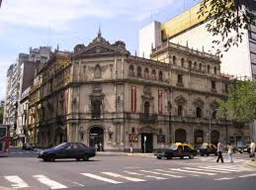
Who is this theatre named after, and why?
Was Miguel de Cervantes Saavedra Jewish? Was his mother?
When did Inquisition end in the Rio de la Plata (Buenos Aires)?
Don Miguel de Cervantes was the author of arguably the most important book in all of Spanish literature: El Quixote of La Mancha. This theatre was named after him. It was the brainchild of María Guerrero and Fernando Díaz de Mendoza, two very respected Spanish actors from the early twentieth century. It offers a strong revival of and resemblance to the Colonial and Spanish styles (we fought the Spanish to become independent, but after the visit of the Infanta in 1910, “we were friends again”) .
It is widely believed Cervantes to be from converted-jewish stock, from a Jewish family that converted to Christianity in Medieval Spain due to persecution under Catholic monarchs. Spain had been welcoming of Jews and Muslims but a new strong monarchy repressed religious variety.
Jews and Muslims were forced to convert and treated with suspicion and cruelty. This reality intensified persecution by the Inquisition.
There are studies that Cervantes, on his mother’s side. was Jewish and though had outwardly converted continued to practise the Jewish faith in secret. Reasons for this include where his mother came from and his subtle references to Judaism in Don Quixote. Specifically a judgement given by Sancho Panza, it appears to be a translation from the Talmud. The scarce meal Don Quixote eats at the beginning of the book is named with a phrase which refers to Jewish mourning and the sorrow of Jews exiled from Spain.
Was Don Quixote’s impossible dream a Jewish one? The French academic Dominique Aubier, whose study “Don Quixote: Prophet of Israel” supports this.
Aubier’s book originally appeared in 1966 and advances controversial theories like that “Don Quixote” contains plenty of Kabbalah and other Jewish themes. The Quixote's very name, says Aubier, derives from the Aramaic qeshot, a word meaning truth or certainty, often used in the Zohar and Kabbalah. Many stories in the Zohar begin with two rabbis “walking on the way.”
Is There a Hidden Jewish Meaning in Don Quixote?
(top...)
How long did inquisition last in Argentina?
How long did inquisition last in Argentina? Still in 1810 and 1812 National leaders Mariano Moreno and Bernardino Rivadavia had to abide to demands from the Holy Office to remit inquised prisoners to the Holy Tribunal. Finally, by 1813 Argentina extends the vote to mestizos and indios, and finally outlaws torture, slavery and... the Inquisition.
(top...)
Embassy of Israel and AMIA Building Bombings
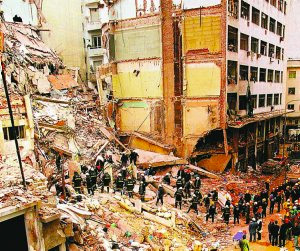
How many Jewish Community buildings bombed in Argentina in the recent decades?
When and where did the first one happened?
How many people were killed?
In 1992 and 1994, bombings were perpetrated against the Argentinean Jewish community and marked the arrival of Middle Eastern terrorism to Argentina.
The Israeli Embassy in Buenos Aires was the site of the first attack with a car bomb in March of 1992. Killing 29 people and injuring over 250 others. Among the victims were Israeli diplomats, children, and people from a church located across the street, and passersby.
For years, however, the investigation lagged and no action was taken, regardless the fact that Islamic groups had claimed responsibility for the explosion.
It was not until July 18, 1994, that the case received serious attention. On that date, the Asociación Mutual Israelita Argentina (AMIA) Jewish community center in Buenos Aires was bombed - 87 people were killed and over 100 people were injured. This time, Jose Galeano the judge, was assigned to investigate the case but, like Levene, he made little progress.
Later in 1994 came the first of several findings in the embassy bombing: several Lebanese and one Brazilian, were found to be members of the Hezbollah, the Iranian-backed terrorist organization in Lebanon, however after several days the suspects were released.
Interest in both these cases arose again 2 years later, when the National Academy of Engineers in Argentina revealed an 'internal explosion theory' that, according to their investigations, a bomb had exploded inside of the State of Israel's Embassy rather than outside in a car. The theory indicated that the Israeli Embassy was attacked by an employee of the embassy rather than by an external enemy terrorist. The engineers who produced this report had blatantly ignored the evidence that indicated a bomb had been set off in a car outside the building and the fact that the Islamic Jihad had admitted responsibility for the attack did not seem to deter the engineers and the Supreme Court from blaming Israelis for their own catastrophe.
Finally, in 1998, a telephone call intercepted at the local Iranian embassy demonstrated without doubt that Iran had part in the attack on the embassy. Argentina expelled Iranian diplomats but that was about the full extent of their actions and it was never determined who was culpable for the attack.
(top...)
Prosecutor Nisman's Death
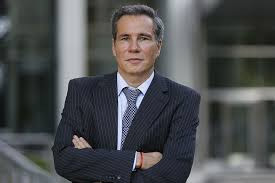
Who 'suicided' Nisman and why?
When was he to present his accusation indicting the Government?
What was he denouncing?
The mysterious death of Argentine special prosecutor Alberto Nisman is the kind of real-life mistery Hollywood producers dream of making into a thriller. But for the people waiting 20 years to have justice for the 85 people killed in the 1994 bombing of the AMIA Jewish community center in Buenos Aires, Nisman’s demise makes hopes of justice dissipate.
Investigating the worst terrorist act in South America required an individual determined to find the truth.
He pursued the investigation with tenacity, seeking to identify and bring to justice those responsible for a heinous attack in Argentina and its Jewish community. The AMIA building was bombed on July 18, 1994, which came just two years after another murderous terrorist attack struck the Israeli Embassy in Buenos Aires.
It was suspected that Iran and Hezbollah were behind the attack, but it was not until Nisman led the investigation that progress was finally made. Until then the official investigation was just a bad joke.
When in 2007, Nisman released a report detailing the involvement of specific Iranian officials. Interpol saw in this evidence so compelling that it issued “red notices” for six Iranians (despite Tehran’s objections), including one who would later serve as Iranian defense minister, and other, a Hezbollah operative, who was later killed in Lebanon.
Five years later, Nisman released another report denouncing that Iran had set up terror cells in various Latin American countries, using mosques, businesses and its own embassies to provide legal cover. For Nisman, the AMIA attack was not about Argentina alone, but about a much larger threat to the region.
His inquiries also probed suspicions of Argentine Government complicity in the terror attack and in attempts to obstruct his investigation. He opposed a 'fishy' 2013 agreement between Argentina and Iran jointly establishing a “truth commission” that would look into the AMIA case. Nisman appealed successfully to an Argentine federal court to declare the truth-commission deal unconstitutional.
Nisman continued. He gave an Argentine court a 300-page document denouncing President Cristina Fernández de Kirchner and Foreign Minister Hector Timerman of doing a conspiracy to protect Iranian officials accused of participating in the murderous attack.
His resolve to answer questions about the bombings led to death threats over the years, yet he showed no signs of fear and moved ahead.
Nisman was found dead in the bathroom of his apartment with a gunshot wound hours only before he was scheduled to brief Argentine parliamentarians at Congress about the evidence against the president and foreign minister he had collected.
Answers about his death are needed but actually unnecessary, for though the chances of getting a full, credible explanation are vague, still there is no doubt he died because he threatened the authorities. After more than 20 years, nobody has been convicted for both the Embassy nor the AMIA bombings. The man who sought justice, Alberto Nisman is now suddenly dead.
(top...)
Was Columbus Jewish?

Can you see the 'S S S A' (kadosh kadosh kadosh Adonai) with C 'Colonis' (servant on earth) followed by 'Anoki' (me) in the signature?
Is this Aramaic, Latin, Spanish or Hebrew?
Can we interpret the symbols on the left of his signature as Shin-Mem-Ayin (shema)?
What year did inquisition start, and when did Columbus leave Spain?
Columbus has been described as a deeply religious man who was committed to the cause of liberating Jerusalem from the Muslims.
Jews were the target of a brutal and systematic ethnic cleansing during the lifetime of Columbus.
As part of fanatical, religious persecution it was proclaimed by Queen Isabella and King Ferdinand in March 1492 that all Jews should be expelled from Spain, just 4 months before Columbus departure.
This move was particularly aimed at the 800,000 Jews who refused to convert to Catholicism and were given just four months to leave the country.
The Jews who stayed in Spain fell into two distinct groups: The 'Conversos' - converted who renounced Judaism - and the 'Marranos', meaning piglets, who would fake conversion but continued secretly with their own religious practices.
The Inquisition in Spaion tortured tens of thousands of jews, who were forced to give up the names of friends and relatives. Marranos were paraded in front of the crowds, tied and burned alive while the crown and the church appropriated their possessions.
It has been claimed that Columbus was a Marrano and that maintaining his Jewish heritage secret was a must to his survival.
Scholars believe he left clear clues to his true religious background upon his death.
Five provisions discovered in Columbus's last will and testament, signed by the explorer on May 19, 1506, point to him being Jewish, the scholars argue.
Firstly, he left one tenth of his income to the poor and outlined another wish that an anonymous dowry be provided for girls with no money - both of which are part of Jewish customs.
He also left an undisclosed amount of money to support the crusade of liberating the Holy Land, as well as leaving funds to a Jew who lived at the entrance of the Lisbon Jewish Quarter.
Perhaps the most intriguing clues are within Columbus's signature itself, the scholars claim.
Columbus used a series of dots and letters - formed in a triangular shape - like those found on gravestones of Jewish cemeteries in Spain, which he asked his heirs to use.
It is believed by one British historian - Cecil Roth, the author of A History of the Marranos - that the signature cryptically replicated a Jewish prayer, the Kaddish, which is usually recited in a synagogue by people mourning the death of a close family member.
This would have allowed Columbus's sons to say Kaddish for their father after his death, it is claimed.
Simon Weisenthat, an historian, has claimed in 'Sails of Hope' that Columbus's real moltivation for his voyage was to find a homeland and safe haven for the Jews following their expulsion from Spain.
The scholars say that, contrary to popular belief, the expedition was not funded by Queen Isabella, but by three prominent Jews who all stumped up 17,000 ducats.
This theory is supported, they say, by the emergence of the first two letters written by Columbus, which were sent to his 'backers' instead of the royal couple, revealing what he had found and thanking them for his support. (Source: Dailymail)
(top...)
Cronology
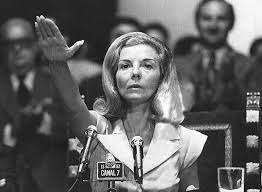
|
| 1974-1976 President Estela Martinez de Peron ('Isabelita'—Evita's successor) at her husband's, General Peron, funeral in 1974. Argentina welcomed Nazi war criminals, with explicit protection from 3 time president Perón for the likes of Erich Priebke, Josef Mengele, Adolf Eichmann, Franz Stangl, Ludwig Lienhardt, Ludwig Freude, Klaus Barbie and Ante Pavelić among others. |
- Are Jews nowadays immigrating to or emigrating from Argentina?
- How many Jews in Argentina?
- What is the status of indictments and prosecution for attacks suffered by the community?
- 1860 - First Jewish wedding in Buenos Aires
- 1888 - First Jewish burials (in non-Jewish cemeteries)
- 1889 - First large Jewish immigration arrives
- 1897 - First Sionist Association is founded
- 1900 - 16,000 Jews in Argentina
- 1909 - SHA (Sociedad Hebraica Argentina) Social Club is founded
- 1910 - First book about Argentine Jewish cowboys: 'Los Gauchos Judios' by Alberto Gerchunoff
- 1910 - First Jewish Cemetery
- 1914 - First Jewish newspaper
- 1916 - First Jewish Hospital rooms started
- 1919 - First local pogroms and persecutions
- 1921 - The Israelite Hospital is inaugurated
- 1925 - Albert Einstein visits Argentina
- 1930 - Jewish operated brothels operation (Zwi Migdal) is banned
- 1932 - Main Temple (Libertad St.) inaugurated
- 1935 - Hacoaj boating & social club founded
- 1940 - First 1000 Jewish kids escaping Europe's war admitted
- 1946 - Jewish centres asttacked
- 1949 - First Israeli ambassador arrives
- 1951 - First visit of Golda Meir
- 1955 - Forceful Christian classes in schools are ended
- 1958 - First two Jewish Governors in Argentina are elected (provinces of Neuquen and Formosa)
- 1959 - New attacks on Jewish community
- 1960 - Capture of Nazi Criminal Adolf Eichmann in Argentina by the Mossad
- 1961 - More (serial) attacks
- 1962 - More attacks: a Jewish girl is kidnapped and a swastika engraved in her chest.
- 1963 - BetEl Community starts new trends in local judaism
- 1964 - New Nationalist attacks: Jewish boy murdered in high school
- 1965 - EmanuEl Community starts reformist trends
- 1967 - Already 48 Jewish schools and 4,000 students attending
- 1968 - Jewish communities start blooming and doing well: 16,000 students
- 1969 - BenGurion visits
- 1970 - Shimon Peres & Albert Sabin visit. American Jewish Comitee estimates local Jewish population to be 500,000
- 1973 - ORT Technical schools inaugurated
- 1974 - New attacks. News editor David Kreiselburd is kidnapped and murdered
- 1975 - The Dean of National University preaches antisemitism openly. New attacks. Bomb on Paso St. Synagogue
- 1978 - Bomb at the SHA (Sociedad Hebraica Argentina) Social Club
- 1986 - The Maguen David is finally allowed in newspaper orbituaries
- 1988 - Buenos Aires and Tel Aviv are declared 'Sister Cities'
- 1992 - Israeli Embassy bombing: over 20 people die. Iran is suspect. No real actions taken by local governement.
- 1993 - Argentina's Supreme Court deters all investigations for years and years
- 1994 - On July 18th a terrible attack against AMIA building: 86 dead and hundreds are injured. Iran is suspect again.
- 1995 - Due to continuous attacks, all Jewish entities build street-side defenses and heighten security
- 1995 - Former Nazi criminal Priebke is taken abroad
- 1998 - Argentine Government blocks and dissasembles important Jewish financial institutions and banks
- 1999 - More Governement damage inflicted to Jewish financial institutions
- 2002 - Many Jews leave Argentina for other countries
- 2004 - Main Jewish Social clubs (SHA/Hacoaj) dissasemble partially, blaming each other. Israelite hospital goes bankrupt.
- 2005 - Local Supreme Court absolves those presumed guilty of the two massive attacks that killed over 100 people
- 1992 - Embassy of Israel bombed: 28 dead
- 1994 - AMIA (Israelite Mutualist Asociation Argentina) bombed: 88 dead
- 2015 - Prosecutor Nisman 'is suicided' (disguised murder) day before accusing Governement in Congress
(top...)
Buenos-Aires-Walking-Tours.com
Reservations (text/call/Whatsapp) in English:
Tel. +1 (250) 884-8787
Call local coordintion / guides on duty:
Tel. +(54 9 11) 6566-5050
|
